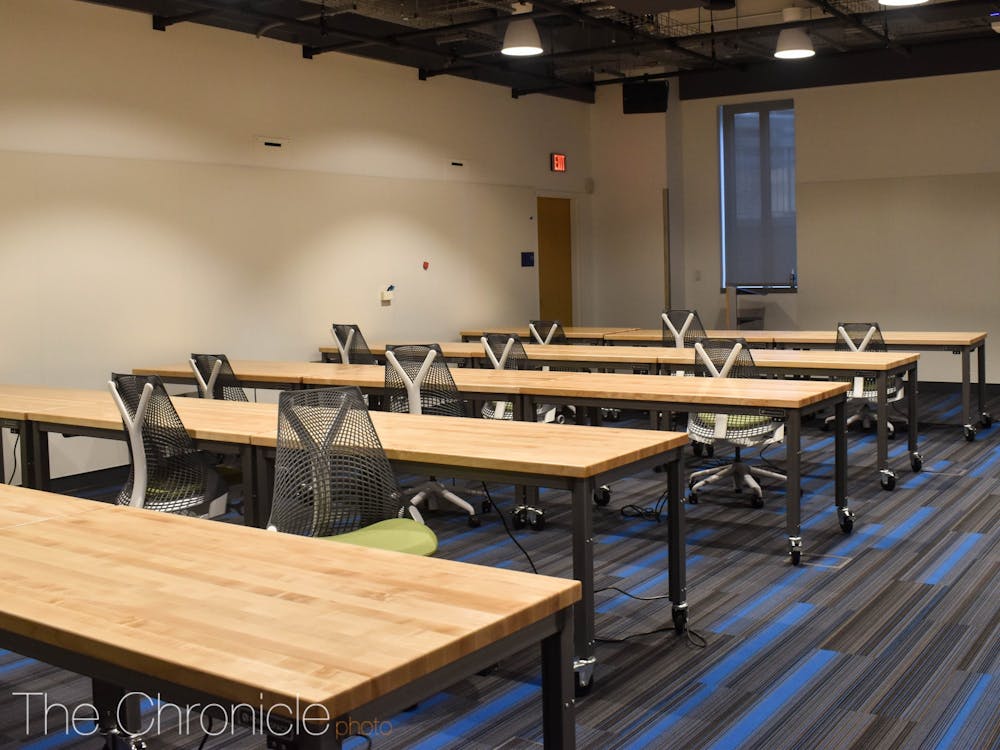To many Duke students, lab work is an essential ingredient to academic success in science, technology, engineering and math fields. For Duke professors on the other side of the equation, it can be just as important a tool for instruction and research.
Yet more than almost any other classroom environment, laboratory sections in courses have come under increased strain due to the COVID-19 pandemic.
Some labs now take place completely online, while others remain in-person with drastically reduced enrollment capacity. In between, an entire array of hybrid options have emerged, all carrying separate risks and benefits as instructors weigh engagement, safety and viability.
In many instances it has been the realities of COVID-19 safety, not instructor preferences, driving the decision.
Before the pandemic, introductory physics labs filled with twenty-five students in each section, working in teams from 8:00 a.m. to 8:00 p.m. Once COVID-19 struck, however, “there’s no way you could do that,” said Steffen Bass, arts and sciences distinguished professor of physics and chair of the physics department.
Adding to the woes, Bass said that half of the graduate students that the labs depend upon to fill teaching assistant positions were unable to return to Durham, stranded overseas due to pandemic-related travel restrictions. To tackle the challenge, Bass said, the physics department devised a series of take-home lab kits, each including the tools necessary to perform classical experiments from the safety of one’s dorm.
The packages made their way to students on campus and around the world and became “real lifesavers,” Bass said providing a “hands-on experience that was the key” for the labs’ success. Bass said that while the efficiency of the learning may have been reduced using the kit format, instructors were still able to cover all the material included in the pre-COVID curriculum.
The biology department faced its own unique challenge— labs that depended critically on in-person physical interaction.
“You cannot learn aseptic technique and how to avoid contaminating things without holding bacteria and working with your hands,” said lab administrator Lindsay Saunders. “The best and only way to learn how to not contaminate things is to contaminate. So you can’t do that from a computer.”
As a result, unlike some physics and chemistry classes, introductory molecular biology and microbiology labs have both remained face to face. Off-campus students can take either course from home, but without the lab component or credit.
Senior Lecturer of Biology Alison Hill, who helped design the molecular biology lab curriculum, agreed that the decision to hold fully in-person labs was a necessary one.
“After spending about a month looking into virtual alternatives ... there was just nothing that would offer our students the same quality experience,” Hill said. “Our lab is such a fundamental part of our course. And it’s always been ranked as a very high learning value by our students.”
To pull off successful face-to-face labs without sacrificing safety, instructors decreased the number of seats available in each Biology 212 and 202 lab section, while also increasing the number of sections offered to promote social distancing. Food microbiology labs, a mainstay of Biology 212, were canceled over the summer due to safety concerns.
Both instructors pounced on the opportunity to re-design aspects of their course. Hill used the flexibility offered by Zoom to pioneer a flipped classroom environment to cover more material in depth, while Saunders overhauled Biology 212’s central research project to emphasize student independence.
Student reaction to in-person labs has been overwhelmingly positive, both agree. Course evaluations were wildly grateful, according to Hill.
“I was overwhelmed at the students who were so thankful for having the opportunity to be in a live classroom,” Hill said. “I mean, some of them said it was the highlight of their week, or the highlight of their semester.”
Sophomore Anthony Tarakji, who moved from attending the virtual labs throughout the fall 2020 semester to attending in-person biology and chemistry labs for this spring 2021 semester, agrees that there’s something irreplaceable about the face-to-face experience.
“It’s really easy to just kind of go through the motions and click things when labs are online. But when you’re actually mixing solvents around and solutes and solutions, you get a little bit more involved,” Tarakji said.
Tarakji said that while some of his friends enjoy the lighter workload of online labs, they can feel forced, reflecting some of the absent richness that Bass, Saunders, and Hill all considered missing from their online-only sections.
For now, students and professors expect that the current lab situation will remain constant, barring any unforeseen twists and turns as COVID-19 continues to play out across the world. Supply chain shortages that initially frustrated laboratory preparation staff have been alleviated, while instructors now feel more confident than ever in their ability to keep lab conditions safe. Hill said that of the over 150 survey responses she received at the end of last semester, only a handful had even minor concerns about lab safety.
In some ways, in-person labs might even be the safer option, Saunders joked.
“If it were ever blatantly apparent that we need to teach our students some hands-on aseptic (germ-free) techniques, it’s right now,” she said, laughing.
Get The Chronicle straight to your inbox
Signup for our weekly newsletter. Cancel at any time.

